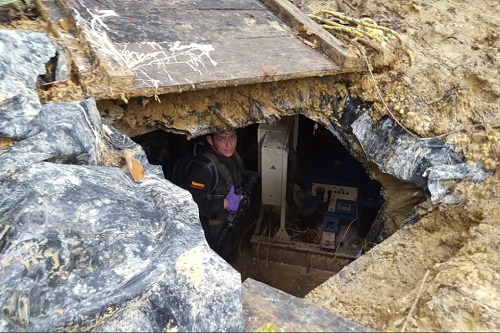Ejercito Nacional photo
By
Ricardo Swire
Coca is one of the most ancient, potent and dangerous stimulants of natural origin. Three thousand years before the birth of Christ the Incas living in the Andes region chewed coca leaves to accelerate their heart rates and breathing to help counter effects of the thin mountain air. The Austrian psychoanalyst Sigmund Freud, who himself used cocaine, was first to promote this narcotic as a tonic to cure depression and sexual impotence.
By the late 1970s Colombian drug traffickers had established an elaborate network for smuggling cocaine to America and Europe. In the early 1990s Colombian cartels produced and exported between five hundred and eight hundred tons of cocaine annually. Internationally coordinated law enforcement operations eventually dismantled Colombia’s mega-cartels in the mid-1990s, but smaller splinter syndicates emerged. Today more than three hundred active Colombian drug smuggling organizations compete for the market share.
As of 2008 cocaine was the second most trafficked illegal drug globally. The trade’s innovation and sophistication are constantly evolving, gasoline added to extract cocaine alkaloids. A tarp covers the tub of chemical mix for twenty-four hours. Someone is assigned to stir the gasoline-coca stew every four or five hours. The individual is also required to taste the brew and verify it is potent enough. If the brew numbed the tongue it was good, if not it needed more chemicals.
On May 21, 2018 Colombian Army counter-drugs division soldiers found an underground drug lab in a strategic trafficking district called Tumaco, south-western department of Narino. Intelligence reports connected the lab, equipped with tunnels, to the “Sinisterra Front” led by a fugitive Ecuadorian national. “Guacho” is a Revolutionary Armed Forces of Colombia (FARC) dissident drug trafficker. His FARC mafia squad fancies adrenalin rushes from kidnapping and murder. Three Ecuadorian press employees, who were kidnapped and killed along the Colombia/Ecuador border, evidence of their handiwork.
Guacho’s underground cocaine lab comprised six structures valued more than pesos 800 million or US$284,000. Inside the clandestine lab soldiers discovered three hundred and thirty gallons of gasoline, two hundred and twenty-five kilos of soda, one power plant, eighteen ovens, six pumps, eighteen industrial heaters, one microwave, one refrigerator, eight thousand meters of copper cable, plus abundant supplies of various liquids and solids used for drug production.
Ricardo Swire
Ricardo Swire is the Principal Consultant at R-L-H Security Consultants & Business Support Services and writes on a number of important issues.



No Comments Yet!
You can be first to comment this post!